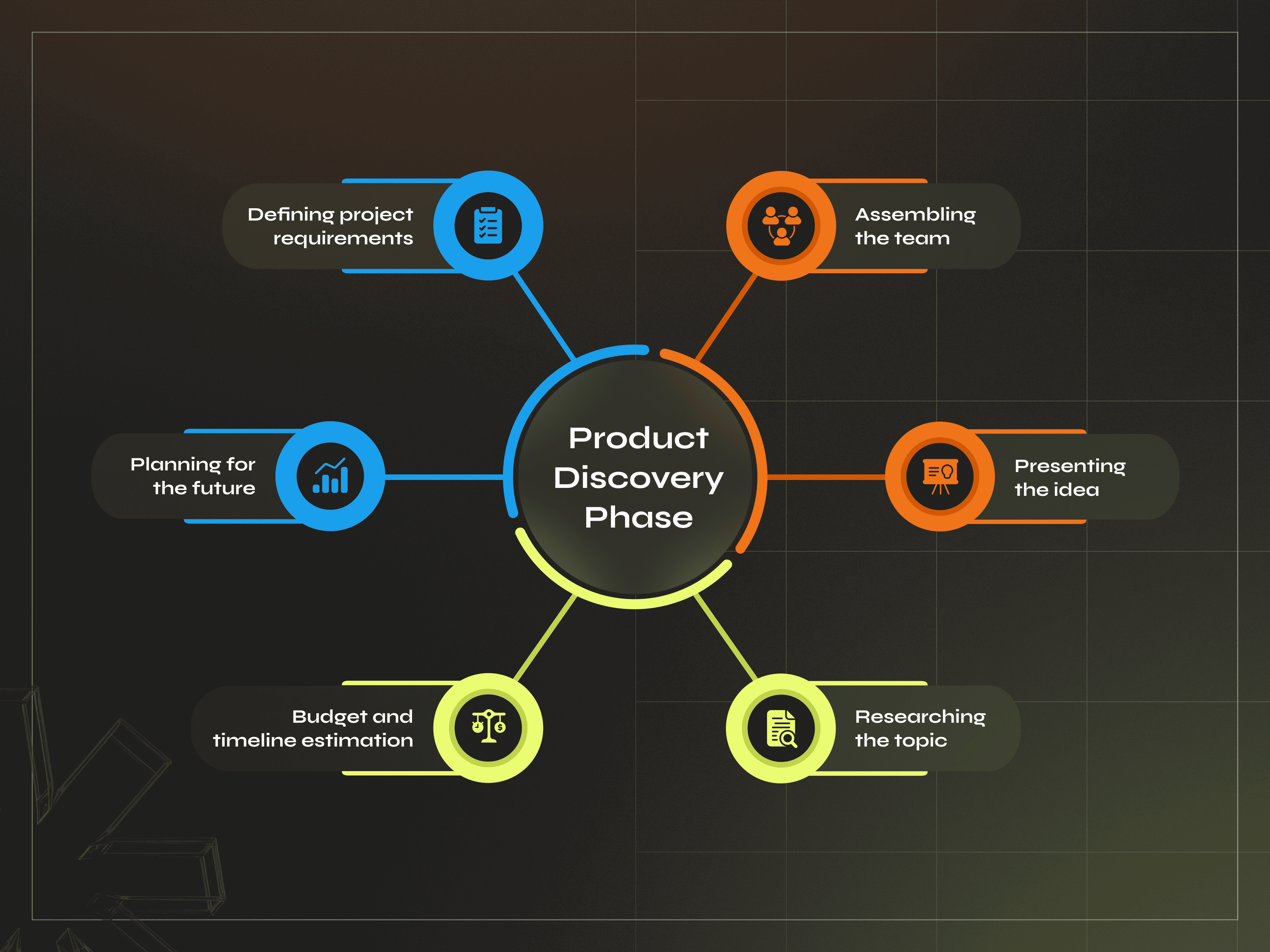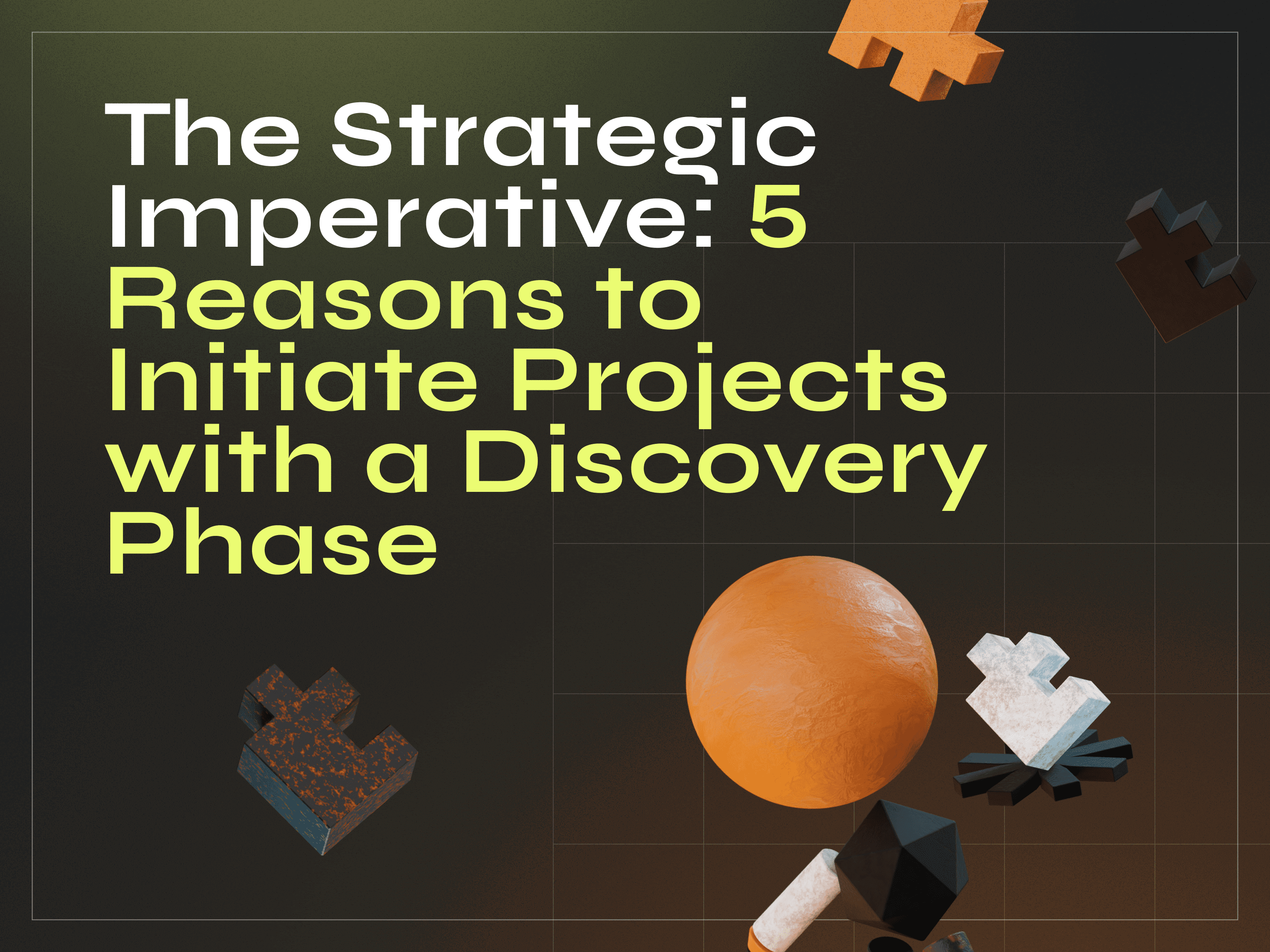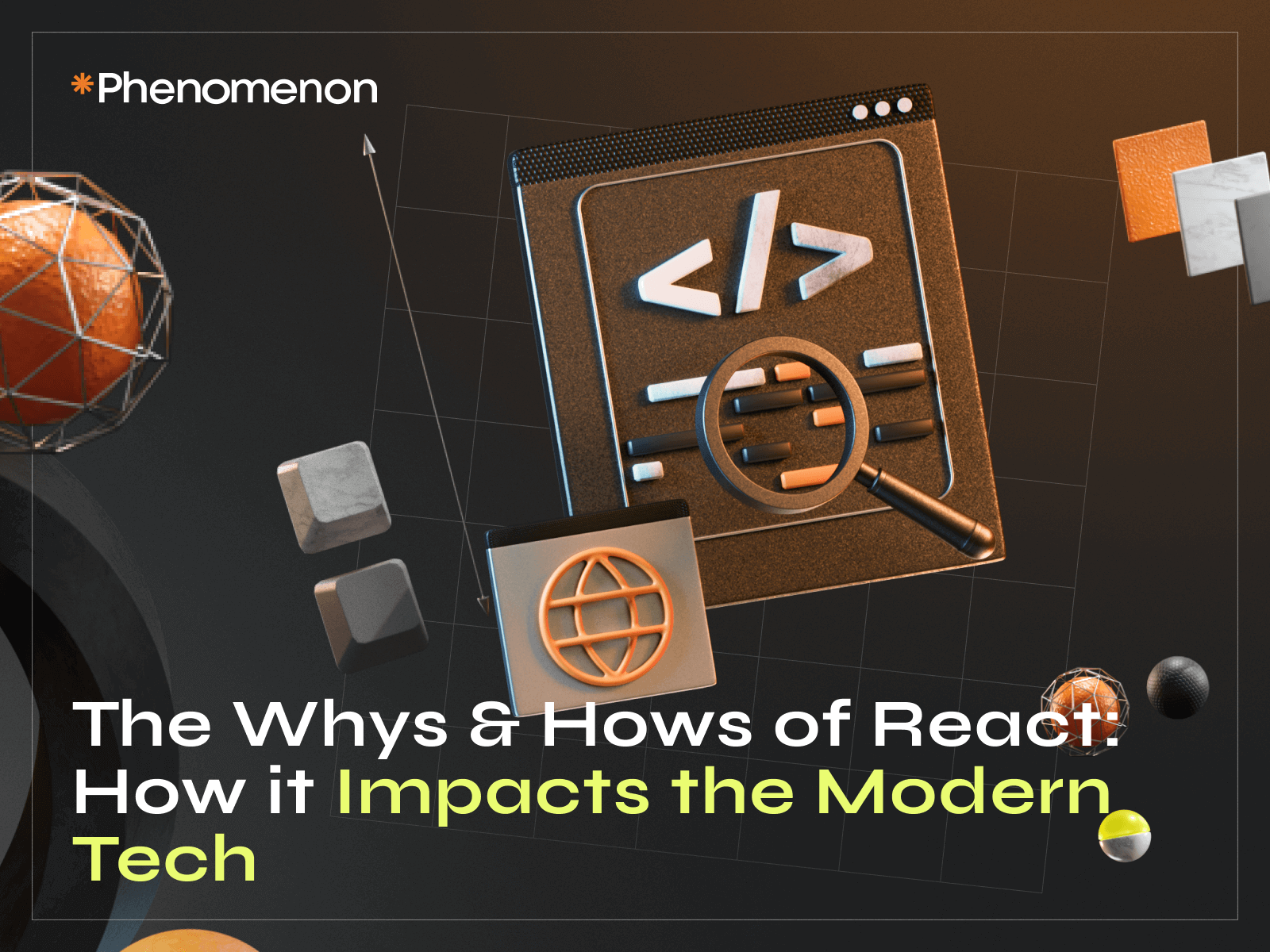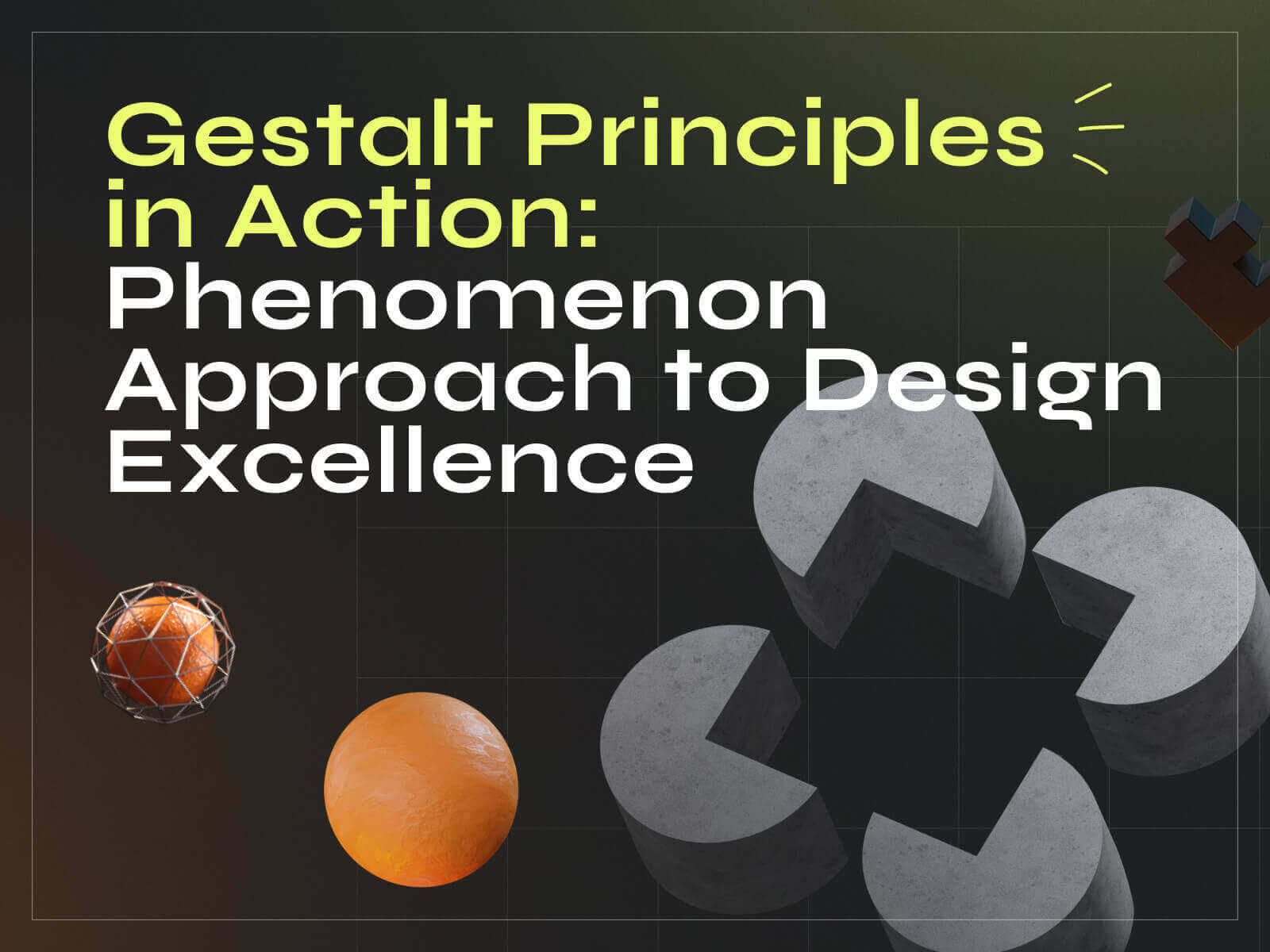Introduction
At Phenomenon Studio, we believe that careful planning and deep market understanding are a must before investing in a project. Why? Because a good start is already half of the success. According to Mckinsey research on software project implementation, the average big IT project exceeds its budget by 45%, with benefits falling 56% short of expectations. In most cases, this happens due to poor planning and a limited understanding of its needs and foals. Building a project blindfolded is never a good idea.
But let’s not be unfounded. Here’s a guide explaining step-by-step why discovery might be the cornerstone of each project.
What’s a Discovery Phase?
The Discovery Phase, often called the scoping phase, is the cornerstone of successful project management. It’s a strategic investment of time and resources at the project’s outset, dedicated to thoroughly understanding its core needs, goals, and feasibility. Think of it as a vital scientific expedition before embarking on a groundbreaking voyage. We validate our initial hypotheses through research, user testing, and competitor analysis to ensure we build the right product or service for the right audience. This meticulous approach equips you with a detailed map, identifies potential hazards, and ensures everyone involved is aligned on the destination.
Here’s a breakdown of the key activities that take place during the Discovery Phase:
1. Stakeholder interviews.
This isn’t a casual chat. The project team interviews key stakeholders, including the CEO and a product owner. By the way, there is rarely a reason not to undertake this type of interview—even if you work closely and frequently with the key decision-makers, you will still need to meet with them to grasp their objectives for every project.
The goal is to gather a comprehensive understanding of:
- Project vision. What problem are we trying to solve? What is the desired outcome?
- Stakeholder needs and expectations. To best understand your needs, Phenomenon gathers key details from our customers. These include target customers and users, current problems and existing solutions, unique value proposition and unfair advantage.
2. Competitor analysis.
The team doesn’t operate in a vacuum. They conduct thorough research on similar projects or existing products in the market. This involves:
- Market research. Analyze market trends, identify potential gaps in the existing solutions, and understand the competitive landscape. For instance, a company developing a new fitness app might research existing apps, their functionalities, strengths, and weaknesses.
- Benchmarking. Identify best practices used by successful competitors. This could involve studying user reviews, analyzing user interfaces, and evaluating competitor marketing strategies. By the way, almost 90% of Fortune 500 Companies use Competitive Intelligence (CI) to gain a competitive advantage, meaning your opponents can be a great data source to inform your strategic decisions.
3. User research.
Understanding the target audience is paramount. The team might conduct user surveys to gather quantitative data on user demographics, preferences, and pain points.
4. Feature usage.
Understanding how users interact with features is crucial. Phenomenon Studio goes beyond just describing features; our BA (Business Analysis) expertise allows us to analyze feature usage data and user feedback. This combined approach helps us prioritize features effectively, ensuring the project focuses on functionalities that deliver the most value. This prioritized list serves as the foundation for project scope and budgeting.
5. Project сhartering.
This crucial document serves as a roadmap for the entire project. Essentially, it’s a formal document that authorizes project managers to begin the work. Based on the insights gathered during the Discovery Phase, the team creates a project charter that outlines:
- Project goals. Clearly defined and measurable objectives for the project.
- Project scope. The boundaries of the project, including what will be delivered and what will be excluded.
- Deliverables. A specific list of tangible outputs expected from the project.
- Timeline. A realistic timeframe for project completion, with key milestones identified.
- Budget. An estimated cost of the project, taking into account resources and personnel needed.
- Roles and Responsibilities. Clearly define who is responsible for what task within the project team.
6. Risk assessments.
No project is without its potential challenges. The Discovery Phase includes identifying potential risks that could derail the project, such as:
- Technical risks. Unforeseen technical hurdles related to software development, hardware compatibility, or integration issues.
- Schedule risks. Potential delays due to resource availability, unexpected dependencies, or external factors.
- Budget risk. Cost overruns due to unforeseen circumstances or changes in scope.
- Stakeholder risks. Disagreements between stakeholders or changes in project direction mid-stream.
The Discovery Phase is an iterative process. As the team gathers information, they may need to revisit and refine certain aspects. This collaborative approach ensures everyone is on the same page and sets the stage for a successful project journey.

The Pitfalls of Skipping Discovery
Skipping the Discovery Phase in a project can lead to significant consequences. One such effect is an incomplete understanding of requirements, which can result in a product that fails to meet user needs. In developing a product, skipping the Discovery Phase might lead to overlooking key features desired by the target users, such as specific functionalities or user interface preferences. This can ultimately lead to dissatisfaction among users and a product that doesn’t achieve its intended goals. Such crucial aspects may go unnoticed without thoroughly exploring requirements during the Discovery Phase, undermining the project’s success.
Furthermore, skipping scope definition increases the likelihood of scope creep, a phenomenon where project scope gradually expands beyond its initial boundaries. For example, in a website development project, failing to define the scope in the Discovery Phase might result in stakeholders requesting additional features during the development process, leading to delays and increased costs. Without clear upfront boundaries, managing stakeholders’ expectations and controlling project scope effectively becomes challenging. This can strain project resources and hinder its successful completion.
Moreover, the absence of early identification of critical issues and dependencies raises the risk of project failure. In app development, bypassing the Discovery Phase can build an unnecessary, overcomplicated, hard-to-use feature that users might not need. Without this proactive approach, these issues may surface later in the project, causing disruptions, delays, and potentially derailing the entire project.
Without clear requirements, projects are prone to rework, leading to increased costs and delays. This is especially true in software development, where assumptions about user needs can lead teams down the wrong path.
Consider two mobile app development projects for social media apps. Company A skips the crucial Discovery Phase, relying solely on assumptions about what users might want. In contrast, Company B prioritizes user research and thoroughly analyzes its competitors through Competitive Intelligence (CI). Through user research, company B can uncover valuable insights that shape its product strategy. These insights inform the development of essential core features everyone uses and, potentially, a unique “wow” feature that elevates their project. This combination – a strong foundation of core functionality paired with a standout feature – positions them for a competitive advantage in the market.
Discovery helps define clear requirements upfront, minimizing rework. Company A’s lack of discovery might lead to an app with features nobody wants and missing functionalities users crave. This would necessitate significant revisions later, causing delays and exceeding budget. Company B, with clear requirements thanks to discovery, is more likely to launch a successful app that resonates with users.

Five Reasons Why Discovery is a Strategic Advantage
Reason 1: Early Identification of Assumptions and Biases
During the Discovery Phase, teams can surface and challenge underlying assumptions and biases that may impact project success. By encouraging critical thinking and open dialogue, organizations can uncover hidden blind spots or preconceptions that could hinder innovation or lead to flawed decision-making. Consider the development of a FinTech application. During discovery, the team might initially assume their target audience is comfortable with complex financial jargon. However, through user research and workshops, the Discovery Phase might reveal a bias toward tech-savvy users, neglecting a significant portion of the market who prefer simpler interfaces and explanations.
Acknowledging and addressing this bias can help the FinTech team develop a more inclusive and customer-centric application. This could involve features like plain-language explanations of financial concepts, interactive tutorials, and multiple interface options catering to different levels of financial literacy.
Reason 2: Cultivation of Cross-Disciplinary Expertise
Discovery usually fosters cross-disciplinary collaboration and knowledge sharing among team members with diverse backgrounds and expertise. By bringing together individuals from different departments, skill sets, and perspectives, organizations can leverage a wide range of insights, experiences, and creative approaches to problem-solving. This interdisciplinary approach enriches the discovery process and cultivates a culture of learning, innovation, and continuous improvement within the organization.
Reason 3: Validation of Hypotheses and Experimentation
Discovery provides a structured framework for testing hypotheses, conducting experiments, and validating ideas before committing significant resources to implementation. Organizations can gather empirical evidence, user feedback, and market insights to inform strategic decision-making and course corrections by adopting an iterative and data-driven approach. This experimental mindset encourages agility, adaptability, and resilience in the face of uncertainty, enabling organizations to respond effectively to changing market dynamics or emerging opportunities.
Reason 4: Creation of Shared Vision and Purpose
Discovery aligns stakeholders around a shared project vision and purpose. Organizations can plan project releases and define the vision and mission through research and collaborative activities like workshops and brainstorming sessions. This process helps identify essential features and their implementation stages, ensuring the project evolves in alignment with stakeholder needs and organizational goals.
For example, developing a new enterprise content management (ECM) system might involve:
- IT executives setting technology strategy.
- Department heads from marketing, sales, and legal outlining content management needs.
- End-users providing feedback on functionality and user interface preferences.
These insights guide the project’s development, fostering ownership, enthusiasm, and strategic alignment.
Reason 5: Empowerment of User-Centered Design Thinking
Finally, Discovery empowers organizations to embrace a user-centered design thinking approach that prioritizes empathy, curiosity, and human-centric innovation. By empathizing with end-users, understanding their needs, and co-creating solutions, organizations can deliver products and services that truly resonate with and add value to people’s lives. This empathetic approach drives customer satisfaction and loyalty and fosters a culture of customer-centricity and empathy within the organization. For example, in designing a healthcare app, involving patients, caregivers, and healthcare professionals in the Discovery Phase ensures that the app addresses real-world challenges and meets the diverse needs of its users, ultimately leading to better health outcomes and patient experiences.
Phenomenon Studio understands firsthand how critical a discovery phase is for understanding your users’ pains. This proved true in our recent project, Aries, a real estate pre-sale system tailored for construction developers, brokers, and sales managers.
The discovery phase was instrumental in uncovering a key challenge: According to our research, each user type – developers, brokers, and sales reps – previously relied on separate platforms.
This discovery directly informed the project’s direction: by identifying this inefficiency, the discovery phase highlighted the need for a combined platform that streamlined processes across all development stages. This user-centric approach is what makes Aries truly transparent and trackable.
This phase was important for Aries because it directly led to the system’s core value proposition: a single platform that unifies the experience for all stakeholders in the real estate pre-sale process.
Discovery Phase: Your Guiding Star
Like in construction, where incomplete architectural plans lead to costly changes, skipping discovery in tech projects creates a foundation for rework and delays. By thoroughly understanding and documenting requirements upfront, project teams can minimize these risks and ensure efficient execution.
Do you have an interesting project for us? Phenomenon is here to help. Contact us and experience measurable results because that’s what working with an industry leader is all about.

















